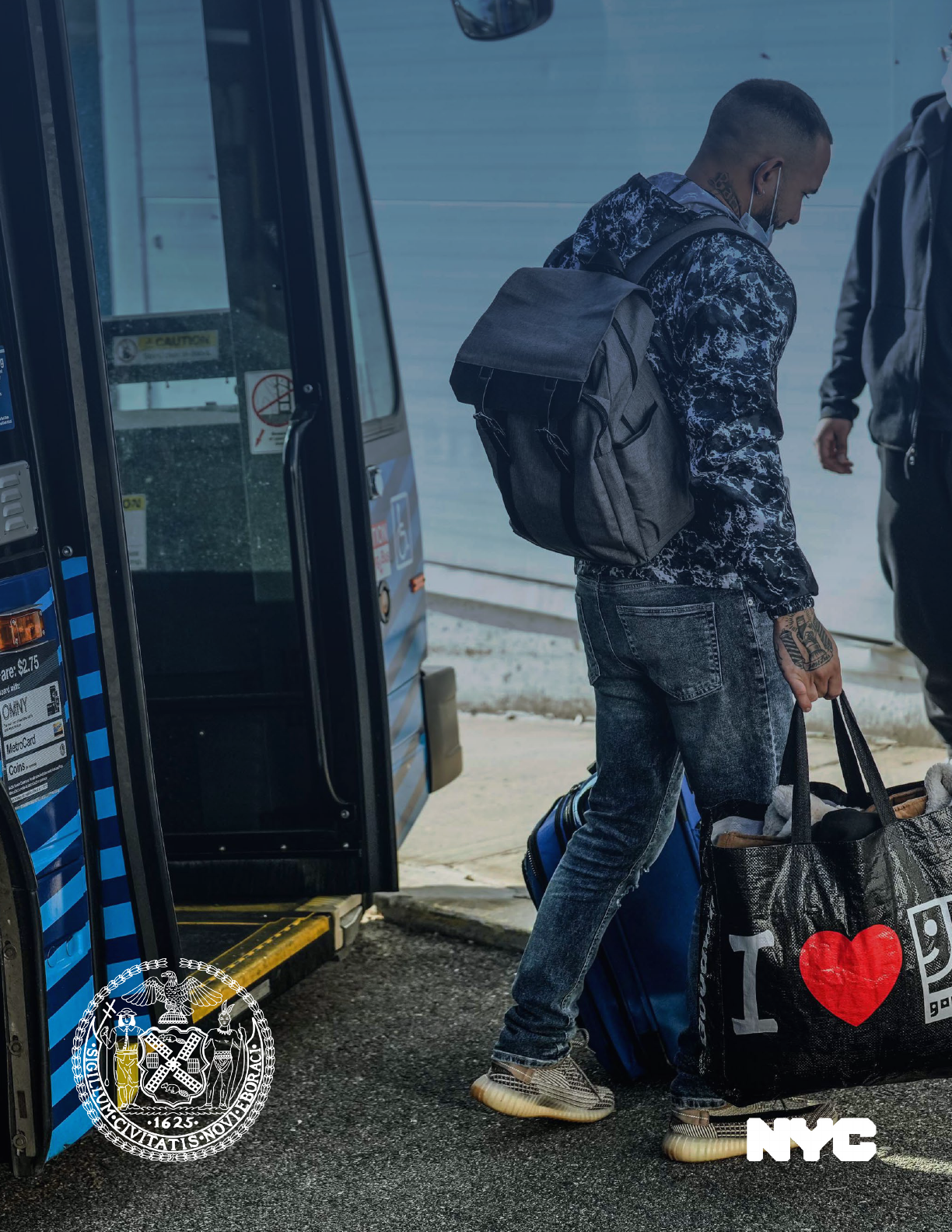
1THE ROAD FORWARD
THE ROAD
FORWARD:
A BLUEPRINT TO ADDRESS NEW
YORK CITY’S RESPONSE TO THE
ASYLUM SEEKER CRISIS

2 THE ROAD FORWARD
Table of Contents
LETTER FROM THE MAYOR .............................................4
LETTER FROM DEPUTY MAYOR ANNE WILLIAMS-ISOM ....................5
INTRODUCTION: NYC’S ASYLUM SEEKER CRISIS AND ITS CAUSES...........7
Background
Cities Leading the Way
SECTION 1: CURRENT MEASURES TO SUPPORT ASYLUM SEEKERS ......... 10
The Navigation Center System
Shelter, Food and Clothing
Legal Assistance
Support for Children/Education
Public Health and Mental Health
SECTION 2: PLANS FOR STEADY STATE OPERATIONS IN NEW YORK CITY ... 15
Office of Asylum Seeker Operations
24/7 Arrival Center
Steady State Initiatives
Relocation, Long-Term Housing and Resettlement
Workforce Development
Legal Services
Collective Responsibility
Interstate & Intercity Coordination
SECTION 3: MOVING FORWARD AS A NATION ...........................23
What We Need From the Federal Government
What We Need From New York State
CONCLUSION.........................................................27
ACKNOWLEDGEMENTS................................................29
APPENDIX ...........................................................30
Asylum Seeker Resource Navigation Center flier
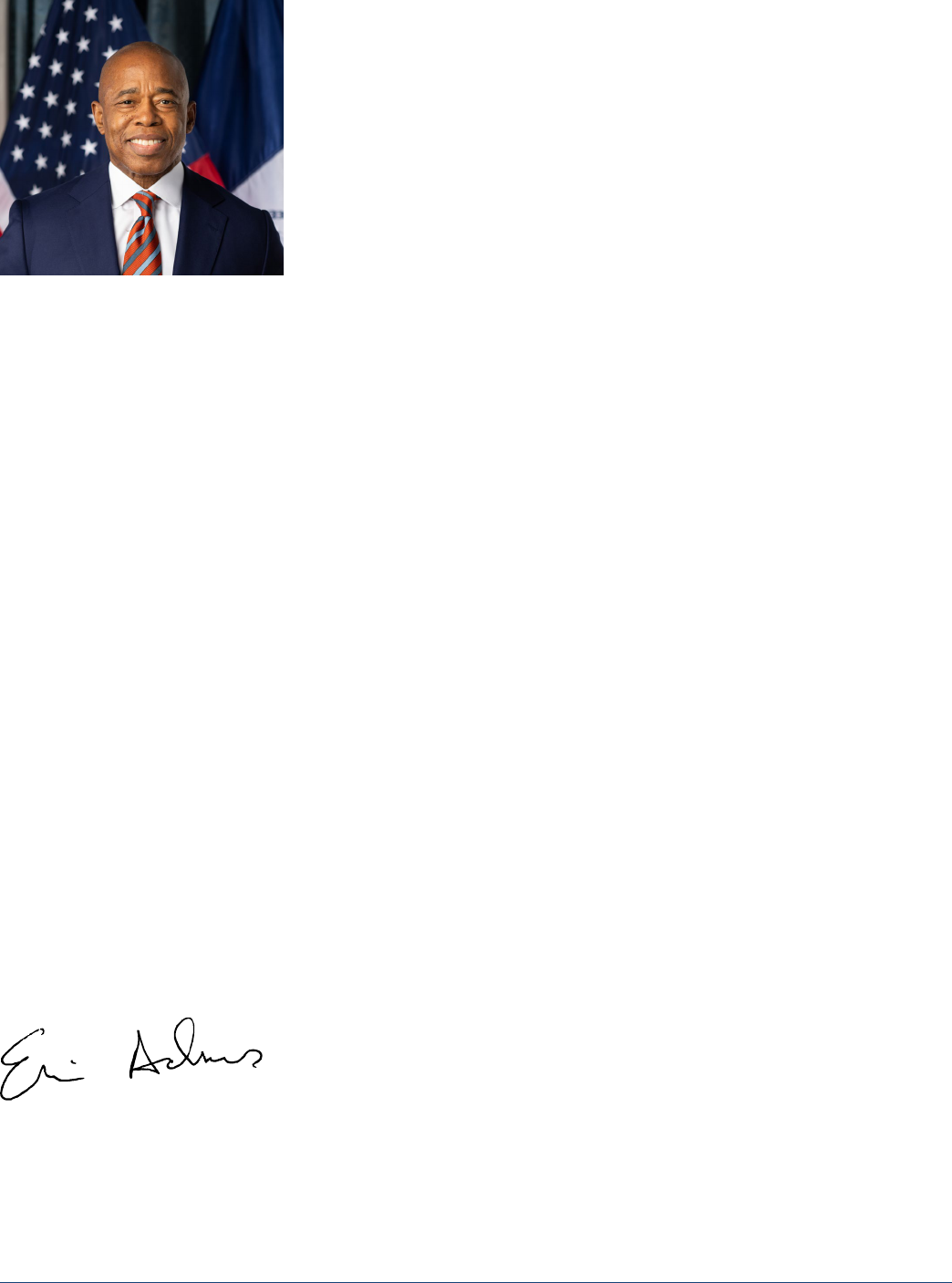
3THE ROAD FORWARD
To my fellow New Yorkers;
New York City has always been a destination for people seeking
freedom, safety, and the chance of a better future. Immigration
is core to our identity as city and our values as a community. And
the thousands of asylum seekers who have arrived here over the
past year are a new chapter in this timeless story.
I am exceptionally proud of how our city has handled this crisis
so far – with energy, resolve, and empathy. Many of the asylum
seekers have spoken to me about their positive reception and
experience – from connecting with relatives and friends to get-
ting children enrolled in school. But as more asylum seekers continue to arrive in our city, we must
plan to ensure they get the help they deserve, without compromising our commitment to all New
Yorkers in need.
That’s what our new plan, The Road Forward: A Blueprint to Address New York City’s Response to
the Asylum Seeker Crisis, is about. This blueprint is a clear-eyed look at what will be needed in the
coming months and years, along with plans to provide shelter, health care, education, legal assis-
tance and more to our brothers and sisters in crisis.
Above all, it is a call for national action in the face of a global humanitarian crisis.
I have spent time with many of the asylum seekers, from greeting them at Port Authority to speak-
ing with them in El Paso. When I visited our southern border, I saw firsthand just how large the
scope of this crisis is – and how important it is that we unite as a nation to address it.
While our city may be the face of the asylum seeker crisis, it is not a crisis we can solve on our own.
A comprehensive response from all levels of government – especially from our state and federal
partners – is needed.
But, as we have so often, cities will lead the way. Our city’s practical and compassionate approach
to the asylum seeker crisis will set the standard for how we welcome those fleeing violence and
hardship. This plan provides a way forward – and will ultimately lead to greater opportunity for
progress for the entire country.
Sincerely,
Mayor Eric Adams
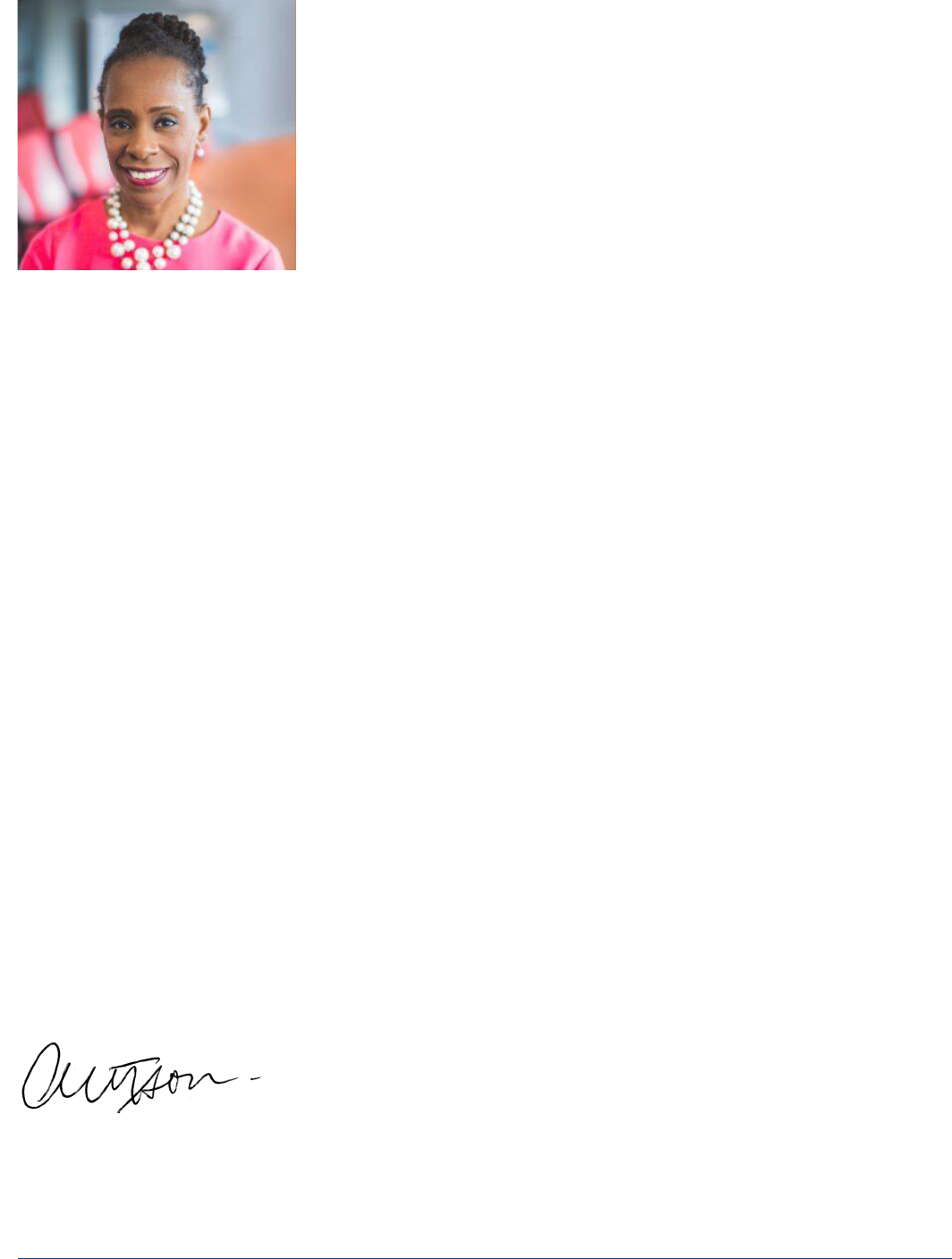
4 THE ROAD FORWARD
My fellow New Yorkers;
Health and human services work many times includes meeting
people where they are to support them on their life’s journey and
designing custom approaches that work for different people. This
means we often encounter people in their most vulnerable mo-
ments - when they are in need of medical care, in need of food
assistance, in need of a roof over their head, in need of support
for their children or older adult family members, or various other
instances. We center those points of engagement with care, dig-
nity, respect, and love for every person, child, and family.
The flow of people seeking asylum in New York City brought all this work to bear, as tens of thou-
sands of individuals, children, and families came seeking shelter from a storm in their lives. We
recognize the root causes of this issue are complex and cut across jurisdictions. New York City has -
and will continue - to support them in every way possible.
The Road Forward: A Blueprint to Address New York City’s Response to the Asylum Seeker Crisis
lays out how we’ve addressed the situation to date and charts a path forward to help those seeking
asylum in this new chapter of their lives. The plan highlights the enormous collaboration among
city government, nonprofit providers, advocates, and experts across emergency management, so-
cial services, medicine, and humanitarian relief.
A core part of the plan is creating a new Office of Asylum Seeker Operations. This central office will
coordinate the City’s response and lead collaborative efforts with nonprofits/community service
providers, state and federal partners, and everyday New Yorkers looking to do their part to help
through volunteerism. Additionally, the city will focus on long-term relocation and resettlement.
We will also work with our partners as they provide guidance on navigating the federal legal pro-
cess around asylum application and workforce authorization.
We know this humanitarian effort is not yet over. We are committed to meeting the need as this
situation continues, and we know this issue is complex, interconnected, and requires deep collabo-
ration across city, state, federal government, and all sectors of society to support our newest neigh-
bors and their families.
I am honored to play a role in managing the city’s response to this crisis. Through our work in New
York City, we are showing that kindness, care, and love are alive and well in America.
Sincerely,
Deputy Mayor Anne Williams-Isom
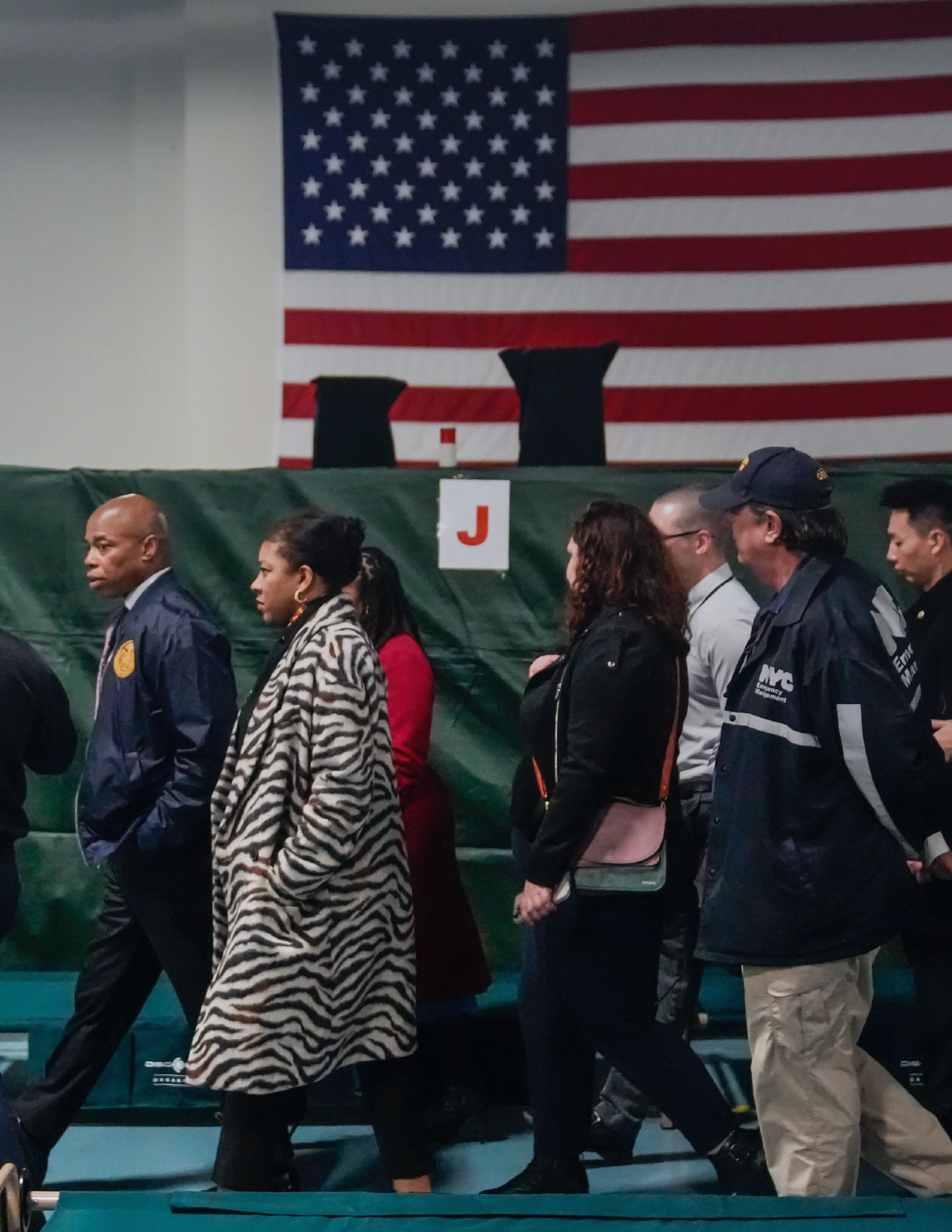
5THE ROAD FORWARD
Introduction: New York
City’s Response to the
Asylum Seeker Crisis
and Its Causes.

6 THE ROAD FORWARD
INTRODUCTION: New York City’s Response to the Asylum Seeker
Crisis and Its Causes
Since last year, tens of thousands of asylum seekers — adults as well as families with children —
have fled dire conditions in their home countries and crossed the United States’ southern border in
search of safety and a better life. Unlike previous groups of migrants and asylum seekers, the new
arrivals are less likely to have a friend, family, or sponsor to turn to for help. Many are traumatized by
their journeys and have been in this country for only a few days before being bused to our city with
little more than the clothes on their backs.
New York City has and always will be a city of immigrants, and we are proud of our compassionate
response to the sudden influx of newcomers. We quickly mobilized multiple city agencies to pro-
vide shelter, food, health care, education, and other critical services — as well as a warm welcome.
However, as the surge of asylum seekers has continued, it has strained the city’s already over-taxed
shelter system, social services, and other resources to the breaking point. To address this humani-
tarian crisis, Mayor Adams declared a state of emergency in October of 2022.
The crisis has only deepened since then. As of March 2023, there were 79,937 people in shelter
placement in New York City (including humanitarian relief centers) — a 77% increase since the
start of the Adams administration on January 1st, 2022. This is due in large part to the influx of
newcomers. Our shelter system is full, and we are running out of funds, staff, and space. Without
additional support, we may not be able to continue supporting recent arrivals along with our pre-
existing shelter population. We may also have to cut back on city programs and services. With new
asylum seekers continuing to arrive each day, we urgently call on all levels of government and all
sectors of society to assist us in creating long-term and sustainable solutions to this crisis.
Background
Although the asylum seeker crisis appears to have occurred “overnight” — or over the course of just
a few months — it is important to understand that it is the result of decades of inaction by Con-
gress and previous presidential administrations. While municipalities like New York City, Chicago,
El Paso, Houston, and Washington, D.C. have expended substantial resources and stretched them-
selves to the limit to respond, the problem has not been created by local governments.
Failure to pass comprehensive immigration reform since the Immigration Reform and Control Act
of 1986, policy decisions made in the previous presidential administration, global instability, climate
change and climate migration, along with overwhelmed immigration courts, and limited paths to
legal permanent resident status, have all exacerbated the crisis.
The situation may also continue to worsen as the country braces for an expected increase in arrivals
when Title 42 is lifted. This public health rule allows officials to turn away migrants during certain
public health emergencies, and it was invoked at the onset of the COVID-19 pandemic. However,
even with Title 42 and other federal border policies in place, New York City has received a record
number of asylum seekers, and continues to receive a steady stream into shelter daily. During
January, the southern border experienced a 97% decrease in border crossings, yet New York City
processed approximately 3,100 asylum seekers in our shelter system in the week of January 3rd to
9th, including 835 individuals in a single day. This was the largest one-day increase of asylum seek-
ers into our care ever. Currently, asylum seekers account for 39% of the total population between
our shelter system and our humanitarian relief centers. If current trends continue, by June 2023, we
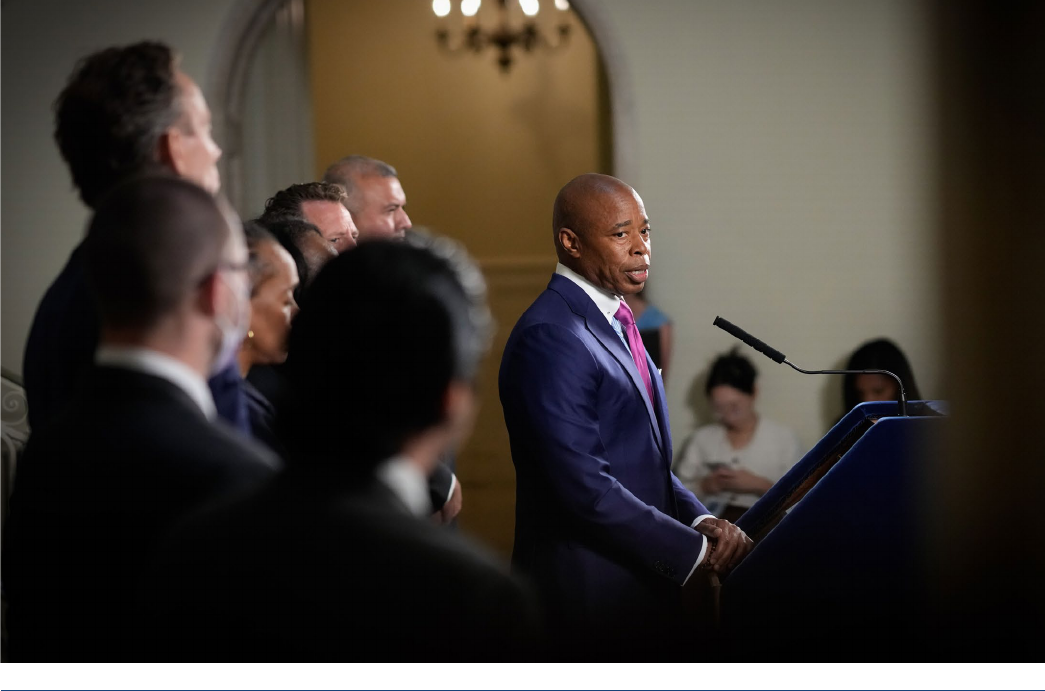
7THE ROAD FORWARD
could see the daily population of individuals in our care increase by 100% from when we came into
office.
Municipalities should not have to bear the responsibility for a complex national problem driven by
global forces. A robust, swift, and comprehensive response from all levels of government — and
especially from the state and federal governments — is required to adequately address what is an
international humanitarian crisis.
We urge the state and federal governments to work with us, particularly with respect to allocating
emergency financial assistance, taking legislative action, and breaking the bureaucratic impasse —
all of which are outside the jurisdiction of municipal governments. A comprehensive federal strate-
gy that allows for safe and legal migration would reduce the strain on municipalities and make the
process more humane for everyone involved.
Cities Leading the Way
Cities like New York have firsthand experience of what it takes to help asylum seekers integrate into
our communities, find shelter, and navigate the legal system. The lessons we have learned, and the
insights we have gained provide a model for other municipalities to follow, and should influence
and inform federal asylum-seeker and immigration legislation and policy.
New York City’s bold and caring approach to the asylum seeker crisis sets a high bar for how we
welcome those who come to our country seeking refuge. The roadmap outlined here provides a
way forward — a way to turn a crisis into an opportunity for progress for the entire country.
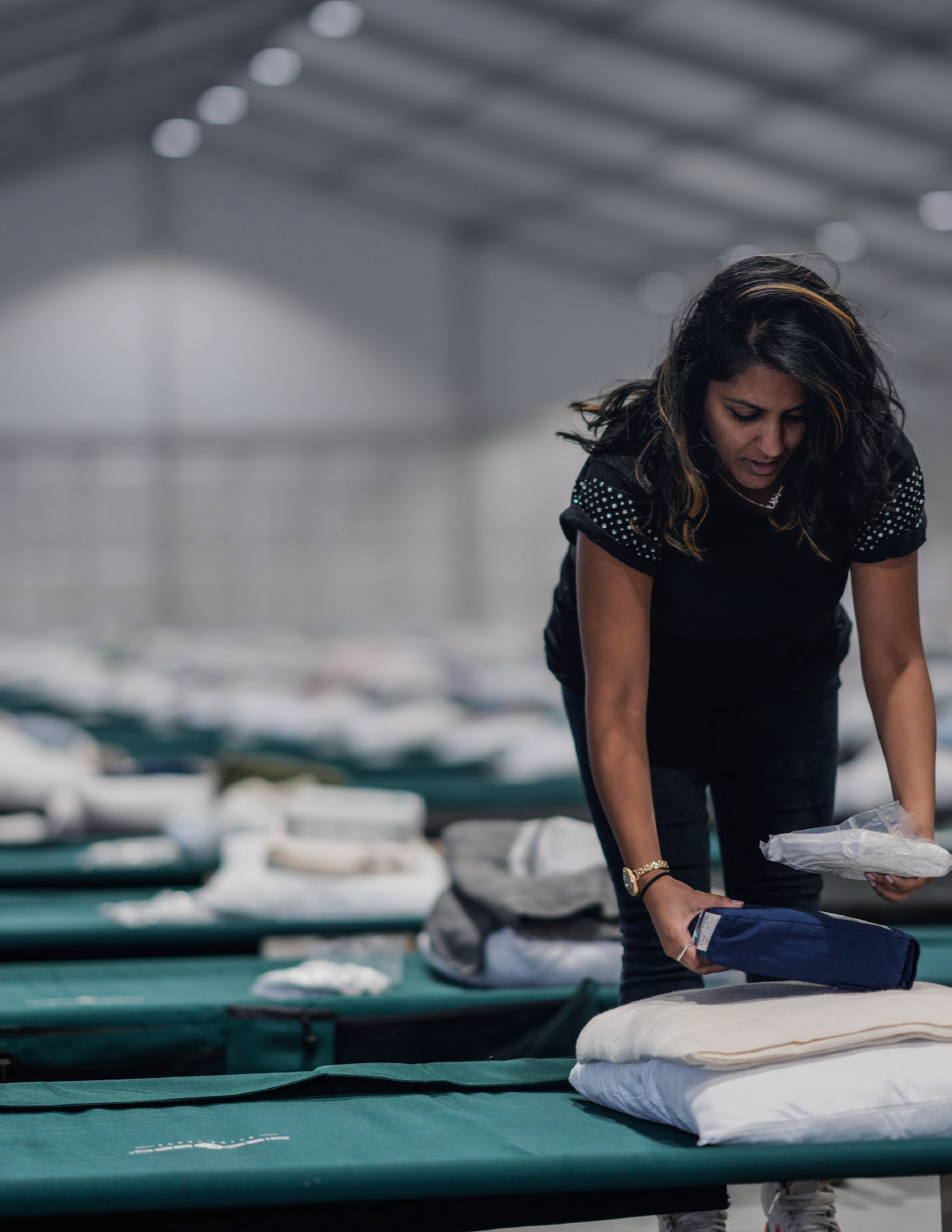
8 THE ROAD FORWARD
Section 1: Current
Measures to Support
Asylum Seekers

9THE ROAD FORWARD
Section 1: Current Measures to Support Asylum Seekers
Over the last year, New York City officials have worked tirelessly alongside community and faith-
based partners to provide critical services to tens of thousands of asylum seekers, many of whom
arrive in our city at all hours from other states. We offer them shelter, food, clothing, and health
care, as well as access to legal information and education in culturally appropriate languages.
To date, New York City has spent more than $650 million on our efforts. We project spending $1.4
billion this fiscal year and $4.2 billion through next fiscal year on this crisis.
Our efforts include creating a Navigation Center system and offering an array of essential supports
and services.
Navigation Center System
In order to ease access and provide connections to services, the city launched a first-of-its-kind
Asylum Seeker Navigation Center operated by Catholic Charities of New York, with 12 additional sat-
ellite sites run by Community Based Organizations (CBOs) across the five boroughs. As of February
1st, 2023, this system has served over 14,680 asylum seekers.
The Navigation Center system, which is supported in the current year with $6.75 million, serves as a
central location and referral network for asylum seekers to receive free and confidential assistance
in navigating necessary services, including health care, Medicaid enrollment, vaccinations, school
enrollment, immigration legal orientation, and IDNYC enrollment.
Shelter, Food, and Clothing
The city continues to meet the sheltering needs of asylum seekers, in some cases opening sever-
al sites a day. To date, the New York City Department of Social Services (DSS) and its not-for-profit
partners have opened 92 emergency shelter sites, and NYC Health + Hospitals (H+H) has opened
7 Humanitarian Emergency Response and Relief Centers to meet our unprecedented need. While
the average amount of time to open a shelter is normally two years, in one year the city has opened
99 sites for asylum seekers. Between the emergency shelter sites and humanitarian relief centers,
the city is currently providing shelter to 30,900 individuals.
Working with CBO partners and nonprofits, asylum seekers in the city’s care are offered food, cloth-
ing, medical care, vaccines, relocation services, legal information, access to translation, laundry, and
more. Everyday New Yorkers have also stepped up, donating food, clothing, books and toys. And
over 60 houses of worship have participated in our Adopt-A-Shelter Program and provided basic
necessities and support to asylum seekers.
Legal Assistance
The Mayor’s Office of Immigrant Affairs (MOIA) and its partner agencies have helped asylum seek-
ers navigate the complex federal immigration process in a number of ways.
At the Port Authority bus terminal, the Asylum Seeker Navigation Center and its satellite sites, and
at humanitarian relief centers, newly arrived asylum seekers were provided with multilingual legal
information. Volunteer attorneys were on hand to help with screenings and legal information.

10 THE ROAD FORWARD
The city allocated $5 million, along with $3 million from the state, to support these efforts. In addi-
tion, $67 million in immigration legal services available to all immigrant New Yorkers will expand
citywide access to legal information and assistance through presentations, online resources, train-
ing for community members, added capacity for the Action NYC hotline and pro se (self-help)
application assistance clinics.
Support for Children/Education
The New York City Department of Education (DOE) launched ‘Project Open Arms’ to assist over
13,700 students in temporary housing currently enrolled in our schools. At the Navigation Center
and humanitarian relief centers, bilingual and multilingual enrollment counselors help parents
navigate placement options for new students (including those with special needs). Staff coordinate
donations with local CBOs, individual donors, and school communities for items such as backpacks,
school supplies, hygiene kits, and clothing.
To support students once they are enrolled, DOE conducts assessments to determine if addition-
al resources are needed (e.g. special education, bilingual programs). School counselors and social
workers assist asylum seeker families to ensure that students’ needs, such as language instruction,
are being met.
Mayor Adams also announced PROMISE NYC, a program to make child care assistance available to
low-income families, including asylum seekers, whose immigration status makes them ineligible
for other federally-funded child care.
Public Health and Mental Health
Asylum seekers face unique challenges that impact their health. The health systems in many of
their countries of origin are unstable, which results in low levels of vaccination, screening and treat-
ment for communicable diseases such as tuberculosis, measles, and polio. For instance, the mea-
sles and polio vaccination rate in Venezuela — the country of origin for many of the asylum seekers
in New York City — is 37% and 50% respectively. Additionally, the arduous journey to the United
States — averaging 2,000 to 3,000 miles — poses many risks to individuals’ mental and physical
health.
At the Navigation Center and in humanitarian relief centers, the New York City Department of
Health and Mental Hygiene (DOHMH) and partners enroll people in insurance programs, and make
appointments with health care providers. To address the increased demand for health care ser-
vices, the city has been working closely with the H+H system and Federally Qualified Health Cen-
ters to expand appointment availability for the newly-arrived asylum seekers.
The city is also addressing the vaccination needs of asylum seekers. At humanitarian relief centers
and the Navigation Center, H+H has provided more than 7,000 vaccines to children alone. Children
have substantial vaccination needs, including MMR (measles, mumps, and rubella), Polio, COVID-19,
Hepatitis and Varicella. Students in New York City are required to get certain vaccines in order to
attend childcare or school within 30 days of enrollment.
Given the conditions in their countries of origin, the journey to the United States, and assimilation
challenges once here, asylum seekers experience high levels of trauma. The Navigation Center
offers crisis counseling and psychological first aid. The humanitarian relief centers also have social
workers on site. Those who need additional support are referred to NYC Well and matched with
mental health providers so that they can receive crisis intervention and referrals.
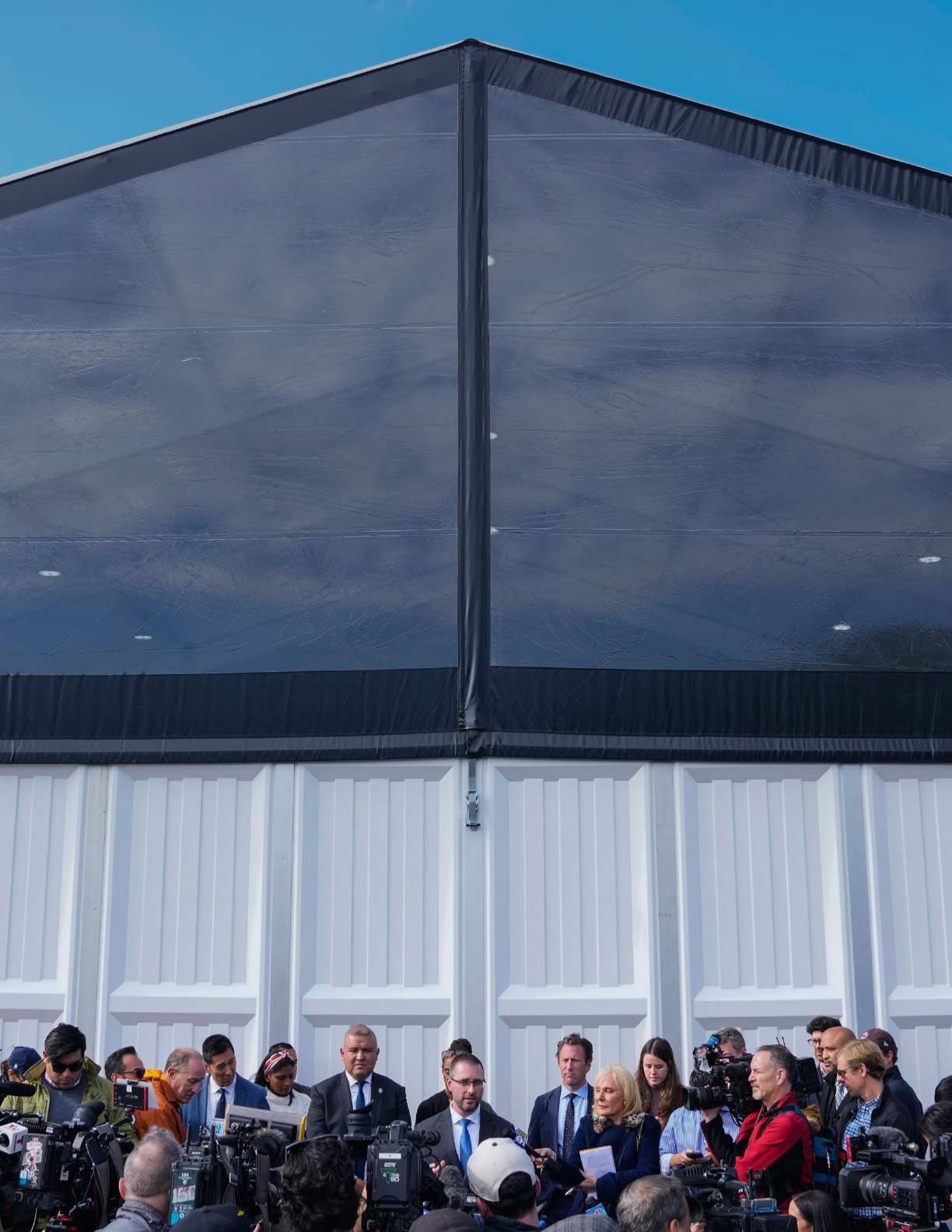
11THE ROAD FORWARD
Section 2: Plans for
Steady State Operations
in New York City

12 THE ROAD FORWARD
Section 2: Plans for Steady State Operations in New York City
The asylum seeker crisis has cost the city hundreds of millions of dollars and redirected many city
agencies’ and CBO staff away from their everyday responsibilities. To give just one example, MOIA,
the Mayor’s Public Engagement Unit (PEU), NYC Emergency Management (NYCEM), and commu-
nity-based partners have spent 16-hour days at the Port Authority bus terminal for months in order
to welcome asylum seekers.
For the long-term functioning of our city, and for the benefit of these newest New Yorkers, we must
put asylum seekers on the path to stability. We must transition from our round-the-clock emer-
gency response to a steady state approach that prioritizes sustainability.
Office of Asylum Seeker Operations (OASO)
New York City’s steady state approach will include a new Office of Asylum Seeker Operations
(OASO) to oversee our ongoing and future activities, and allow existing city agencies to refocus on
their core missions. The OASO will coordinate between agencies, make sure that agencies have the
resources they need, and manage our advocacy to the state and federal governments.
The OASO will also ensure that all newly arrived asylum seekers who need temporary shelter have
access to a safe place to sleep, food, and other basic necessities. And by coordinating with federal,
state, and national partners, it will create a pathway for asylum seekers to connect with opportuni-
ties and support throughout the country.
24/7 Arrival Center
A new centralized 24/7 Arrival Center will replace the Port Authority bus terminal as a primary des-

13THE ROAD FORWARD
tination for asylum seekers. Here, trusted community based partners with experience in resettle-
ment will provide reticketing services, shelter intake, legal information and medical triage. Current-
ly, these services are bifurcated across multiple sites.
The 24/7 Arrival Center will enable the OASO to obtain a complete picture of asylum-seekers’ needs,
and focus on resettlement efforts. This will allow newcomers to be assisted appropriately and pro-
vide information to help New York City make data-driven decisions. In addition, the Arrival Center
will prioritize steps that put asylum seekers on the pathway to work authorization.
Steady State Initiatives
The following five Steady State Initiatives will fall under the purview of OASO, once it is created. In
the meantime, existing city agencies will continue to make headway in these key areas:
1. Relocation, Long-Term Housing, and Resettlement
Prior to the current asylum seeker crisis, homelessness was already a major challenge in our city.
Tens of thousands of New Yorkers, a majority of whom are children and families, live in the city’s
shelters. The city remains steadfast on moving both New Yorkers experiencing homelessness and
recently arrived asylum seekers out of temporary shelter and into permanent housing. Our goal is
to provide safe, affordable, and stable housing options to those in need, regardless of their immi-
gration status.
The city will continue to explore short- and long-term options to house asylum seekers, including
ways in which houses of worship can shelter asylum seekers. In doing so, faith based organizations
will not only expand the city’s shelter capacity but also help integrate migrants into local communi-
ties.

14 THE ROAD FORWARD
The city is also in the early stage of being able to assist asylum seekers in relocating to their pre-
ferred city of choice. Ultimately, New York City isn’t equipped to meet the complex needs of asylum
seekers given their current rapid rate of arrival. The OASO will oversee outreach activities including
door knocking and community engagement to ensure that all asylum seekers are aware of reloca-
tion opportunities.
For relocation within New York State, the recently released state budget includes $25 million to
assist in the resettlement of certain families. The New York State Office of Temporary and Disabil-
ity Assistance (OTDA) will administer and oversee the program, which will include contracts with
nonprofit organizations who have proven experience in successfully resettling refugee populations.
New York State will pay for up to one year of the cost of housing for these families, as well as case
management and related services.
The city is also looking at other ways to resettle asylum seekers throughout the state. The migrant
workforce training pilot, in partnership with The Center for Discovery and SUNY Sullivan, will offer
asylum seekers the opportunity to relocate to Sullivan County, attend SUNY Sullivan Communi-
ty College, live in college residence halls and earn a post-secondary credential or degree. Asylum
seekers will also receive workforce training through The Center for Discovery in health care, human
services, hospitality, culinary, and agricultural sectors. One of the program’s goals is to develop a
blueprint so that others around the state can replicate the model.
At the same time, the city is engaging national nonprofits to offer asylum seekers an even wider
array of relocation choices. Resettlement options will consist of pre-vetted cities and municipalities
that welcome asylum seekers. Ultimately, this program will utilize a warm handoff resettlement
approach with ongoing contact after resettlement to ensure the best possible outcomes.
2. Workforce Development
Although an average of more than 82,200 new jobs have been posted every month in New York
City in 2022, the federal government requires asylum seekers to wait for years to receive work per-
mits. This exacerbates the challenges that both migrants and the city face. The cost of providing for
asylum seekers because of their inability to work legally is becoming increasingly unsustainable for
our municipal government.
Allowing asylum seekers to work while their immigration claims are being processed helps fill job
vacancies, creates self-sufficiency, and reduces reliance on the city’s strained shelter and support
system.
In the meantime, New York City will assist asylum seekers as they move through the asylum and
workforce authorization process. This will include:
• Partnering with community based organizations and others to identify asylum seekers who
are eligible for work permits.
• Providing Occupational Safety and Health Administration (OSHA) training; and developing
appropriate opportunities for job training in targeted, in-demand industries, such as
healthcare and food service.
• Funding CBOs to provide adult literacy services at humanitarian relief centers.
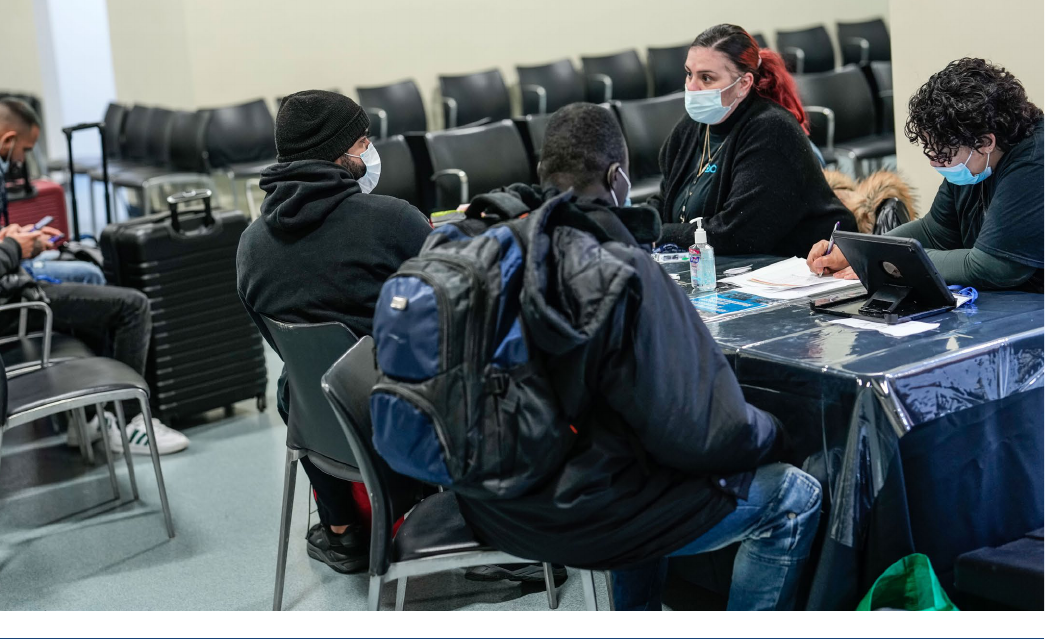
15THE ROAD FORWARD
• Offering workplace rights and anti-fraud education. Immigrants and low-wage workers are
among those most vulnerable to labor law violations by employers. This includes paying
below minimum wage, wage theft, and stealing tips.
• Connecting new arrivals with more established immigrants to serve as mentors. These
mentors are best positioned to connect asylum seekers with resources and information
accessible within existing immigrant networks of support.
3. Legal Services
Providing asylum seekers with access to legal support is one of the most critical services the city
can offer. As part of our transition from an emergency state to a steady state, we are creating a new
comprehensive framework for legal support, and will offer a centralized system to support asylum
seekers as they navigate the long and complicated federal immigration process.
We will also engage the legal community and everyday New Yorkers to help provide legal assis-
tance. This effort will take place under a new umbrella initiative launched in coordination with
the Mayor’s Fund to Advance New York City, called the Asylum Seeker Legal Assistance Network
(ASLAN).
The city and state will collaborate with partners across the immigration, asylum seeker, and refugee
policy and services fields to develop a comprehensive plan that puts migrants on the pathway to
work authorization and legal status by:
• Expanding a coordinated outreach effort to connect with asylum seekers currently in the city
system and ensure they are aware of important dates and deadlines around their application.

16 THE ROAD FORWARD
• Establishing a centralized legal information entry point to conduct initial screenings and
offer legal orientation, referrals to immigration legal service providers, and pro se (self-help)
application assistance clinics.
• Using technology to maximize access to information and legal assistance.
• Making an interagency effort to identify and improve city processes that serve as barriers to
accessing immigration benefits and relief.
• Continuing to build the legal capacity of small community based organizations and grow the
cultural and linguistic capacity across legal service providers.
• Recruiting new volunteers to support the legal needs of asylum seekers through a call to
action.
• Convening an advisory board of external immigration legal experts and external partners to
engage in longer-term strategy, planning, and ongoing federal advocacy.
4. Collective Responsibility
The asylum seeker crisis has shown that we need all hands on deck in order to respond effective-
ly. As the city moves toward a steady state, we will encourage external partners to join our efforts
by holding a series of roundtables so that we can problem solve and hear from key stakeholders.
We will also continue to work with our agency partners and the Mayor’s Fund to provide ongoing
financial and in-kind donations to our faith and community based partners.

17THE ROAD FORWARD
Faith Based Organizations have a unique and powerful role to play. These organizations have a
long history of providing humanitarian aid to vulnerable populations. They also have the capacity to
mobilize large numbers of volunteers and resources.
We will continue to work with our faith based partners to provide housing, basic necessities and a
sense of community for our newest New Yorkers. We will encourage our partners to join us in advo-
cating for policy changes and increased resources.
Community Based Organizations, with their deep roots in local communities, linguistic and cul-
tural competency, and expertise in providing social services, also play a critical role. We will keep
partnering with CBOs to provide a variety of services, including housing assistance, workforce de-
velopment, health care, education, job training, resume building, language instruction, and more.
Philanthropic and Corporate Partners make important contributions as well. The Mayor’s Fund to
Advance New York City, a 501-(c)(3) nonprofit, launched the Asylum Seeker Relief Fund in January
2023, with the goal of raising $25 million from philanthropic organizations and corporations. This
will help us and our community based partners meet asylum seekers’ immediate and long-term
needs, such as workforce development, health and wellness, and basic necessities.
Everyday New Yorkers have stepped up and assisted our response. From volunteering at Port Au-
thority, to opening their homes to provide temporary shelter, making charitable donations of mon-
ey, clothing, and other essential items and more, the generosity of New Yorkers has been a shining
example of the best of our city.
We will encourage everyday New Yorkers to volunteer by:
• Developing a recruitment strategy that communicates the impact volunteers have, especially
around asylum seekers’ legal needs.
• Partnering with local organizations and city agencies already working with asylum seekers to
leverage existing volunteer networks.
• Providing resources to help navigate the complexities of working with asylum seekers. This
will include trainings, toolkits, and more.
We will also explore how everyday New Yorkers can provide temporary housing to asylum seekers.
5. Interstate and Interagency Coordination
New York City is well positioned to lead a multi-city coalition to ensure that the national govern-
ment delivers a comprehensive response to this crisis. The coalition could serve as a unified voice in
calling for federal change, and enable cities and localities to share best practices and resources.
The OASO will specifically work with cities at the southern border to dispel misinformation about
what New York City offers and make sure asylum seekers receive accurate information about our
city’s services. We want asylum seekers to have trusted information about the resources available
for them across communities so that they can make informed resettlement decisions.
The OASO will also work with Cities for Action, a program run by MOIA, that includes nearly 200
mayors and local governments across the country who advocate for pro-immigrant federal policies
and programs.
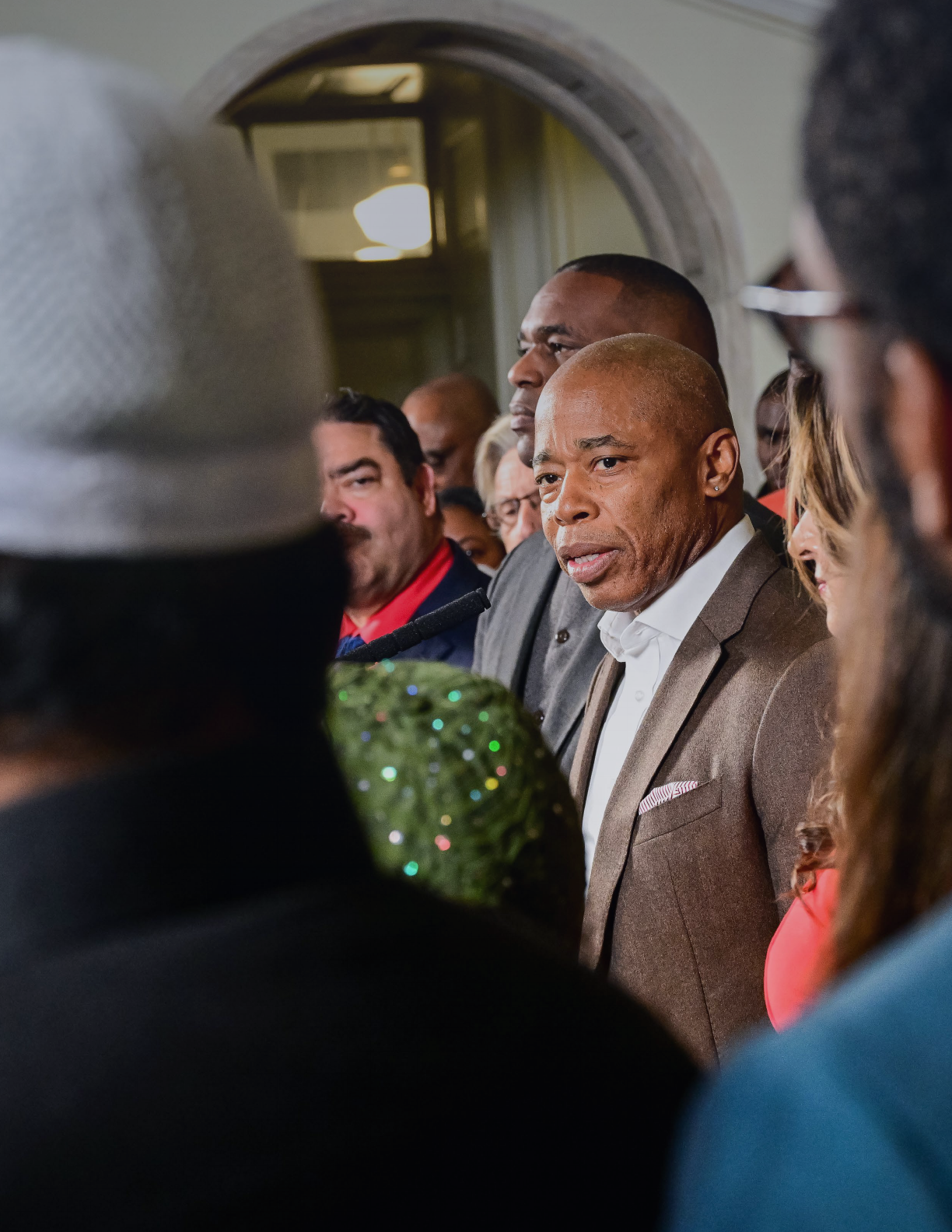
18 THE ROAD FORWARD
Section 3: Moving
Forward As a Nation

19THE ROAD FORWARD
Section #3: Moving Forward As a Nation
To make the process of integrating asylum seekers simpler, fairer, and more humane, we need ur-
gent fiscal, legislative and regulatory changes at the state and federal level.
We are providing the state and federal governments with a list of ‘asks’ to ensure that New York
City and other localities are able to absorb and assist asylum seekers without overextending our
strained resources. We also look to our elected officials to continue to stand with us in our ongoing
collaborative efforts and advocacy.
The Office of Asylum Seeker Operations, once created, will advocate for the measures outlined
below. In the meantime, the city will press the federal and state governments to deliver on these
urgently needed interventions.
What We Need from the Federal Government
We thank the New York City congressional delegation, U.S. Senate Majority Leader Chuck Schum-
er, and U.S. House Minority Leader Hakeem Jeffries for their leadership in providing New York and
other localities with federal funding to help cover a portion of our expenses. However, we still need
more. We are calling for:
• An expedited right-to-work policy for asylum seekers who remain compliant with
immigration enforcement requirements. Immigrants contribute in meaningful ways to our
communities and have been shown to be drivers of economic growth. However, because
those arriving now are not yet legally able to work, they are denied the ability to provide for
themselves and their families, which increases their need for shelter and services.
• A decompression strategy at the border that evaluates asylum claims, establishes a plan
for each migrant’s arrival – before their entry into the U.S. – and creates a system to fairly
distribute newcomers regionally. This ensures that the entire country faces this humanitarian
crisis in a coordinated manner.
• A revamped immigration system that is safe, orderly, and legal. The current system
is confusing and slow, language access and logistical challenges are rampant, and the
dysfunction increases demand for quality low- or no-cost immigration legal services, which
far exceeds the capacity of New York City’s nonprofit immigration legal services field.
Additionally, bureaucratic delays on the federal level have caused an immense backlog in
New York City immigration courts, with over 124,000 cases pending as of December 2022.
The federal government must surge immigration lawyers to the border and to New York City
to relieve the pressure.
• A reduction of administrative burdens and an increase in the rate of homeless housing
placements to accelerate exits from shelter into affordable housing. The web of rules, laws,
and requirements surrounding the city’s affordable housing make the process of accessing
public benefits unnecessarily time-consuming and difficult. In the absence of additional
reforms, migrants will not be able to access rental assistance or other benefit programs.
• A designated leader to resolve the national border crisis and coordinate all relevant
agencies and entities, including those in localities where migrants settle.

20 THE ROAD FORWARD
• Reimbursement for funds already spent by localities on asylum seekers, and adequate
funding moving forward.
• The declaration of a federal emergency to unlock additional funds and operational abilities.
While New York City has thrived by welcoming newcomers for centuries, the costs of meeting
our national asylum seeker crisis should be borne by the federal government.
• The classification of current asylum seekers as refugees to unlock additional resources and
pathways.
• The expansion in the variety of vaccines given at the border to include Varicella and MMR,
and the addition of federal funding for other infectious diseases, emergency preparedness,
and public health infrastructure. This emergency again highlights the need for investment in
our country’s core public health functions.
• The renewal of multi-year mandatory funding for Federal Qualified Health Centers
through reauthorization of the Community Health Centers Fund. New York City leans heavily
on safety net providers to offer health care to asylum seekers and the providers will face a
federal funding cliff in October 2023 without congressional action.
New York City will continue working closely with our federal partners and other cities to push for
increased funding and improved legislative and regulatory changes for asylum seekers. We will
also continue to coordinate with the U.S. Department of Homeland Security, the U.S. Department
of Health and Human Services, and all relevant federal agencies to obtain accurate data on arriving
asylum seekers so that we can develop a balanced placement strategy across the country.
What We Need from New York State
In addition to the funding that New York State has already provided, we are grateful for the state’s
deployment of the National Guard to help with sheltering needs, and to the additional funding
dedicated to this crisis in Governor Hochul’s Fiscal Year 2024 Executive Budget Proposal.
Still, we continue to depend on the state for assistance as asylum seekers arrive in our city.
Our requests of New York State include:
• Providing additional funding for support and services by establishing a program with an
appropriation specifically for costs incurred by the city for shelter, food, and related services
provided to asylum seekers.
• Supporting the creation of a new portable housing voucher program designed with the
goal of providing stable housing for this new population.
• Providing financial assistance for individuals ineligible for federal support and establishing
the NYS Empire Licensing Act, which would provide all New Yorkers with access to
professional, occupational, commercial, or business licenses, permits, certificates, or related
registrations regardless of an applicant’s citizenship or immigration status.
• Creating a more equitable Foundation Aid formula with a methodology that supports
students in temporary housing as well as shifts unspent Title Ill funding back to supporting

21THE ROAD FORWARD
immigrant education. Given the massive influx of asylum seekers who are residing in shelters
and enrolling in New York City schools, this would allow the city to provide vital additional
support to our newest students.
• Urging localities throughout the state to welcome migrants seeking refuge. With
additional funding from New York State, community based organizations can help migrants
settle outside New York City.
• Locating, running, and operating sites outside of and in New York City to provide short and
long-term housing and shelter.
• Creating a joint task force between the state and the city that would be responsible for
creating long-term solutions, developing funding sources and providing advocacy.
• Managing and financially supporting legal services as part of a comprehensive asylum
seekers strategy.
• Declaring a state of emergency and encouraging the federal government to do the same.
State and federal emergency declarations will loosen restrictions on use of funds, and allow
the city more flexibility in supporting asylum seekers.
• Expanding state-funded health care coverage for undocumented adults as many asylum
seekers will likely lose their status — and therefore access to health insurance — and will
need health care coverage in the future.
• Creating permanent adult immunization reporting without adult consent, and expanding
the list of eligible provider types to serve as vaccinators. For instance, allowing pharmacists
to administer vaccines to minors would help in managing current and future outbreaks.
• Restoring the Article 6 funding match. New York City is being reimbursed for medical
expenses at a rate lower than the rest of the state. Restoring the A6 funding match is critical
to our public health infrastructure.

22 THE ROAD FORWARD
Conclusion
This blueprint outlines what we have accomplished, where we are now, and the steps we must take
based on what we have learned through our efforts so far.
The ongoing surge of newcomers seeking refuge has forced us to recognize that migration across
national borders is neither a temporary circumstance nor entirely preventable. Whether due to
political instability or other factors, cities like New York will continue to receive tens of thousands
of migrants and asylum seekers each year. We must work together to overhaul our immigration
system, and make it easier for migrants to begin their new lives.
New Yorkers know that the asylum seeker of today is the citizen, leader, and innovator of tomorrow.
We look forward to continued collaboration with local partners, other cities, New York State, and
the federal government to improve our response and the outcomes for all involved. How we move
forward will determine the future we create for our city, society, and nation.

23THE ROAD FORWARD
Acknowledgements
Thank you to the many individuals, offices and agencies who have helped craft this blueprint.
New York City Agencies
Administration for Children’s Services
Department of Design and Construction
Department of Education
Department of Health and Mental Hygiene
Department of Social Services / Department of Homeless Services / Human Resources
Administration
Emergency Management
Health + Hospitals
Housing Preservation & Development
Law Department
Mayor’s Community Affairs Unit
Mayor’s Fund to Advance New York City
Mayor’s Office of Faith-Based and Community Partnerships
Mayor’s Office of Immigrant Affairs
Mayor’s Office of Operations
Mayor’s Office of Workforce Development
Mayor’s Public Engagement Unit
NYC Service
Office of the Chief Housing Officer
Office of the Chief Technology Officer
Office of Management and Budget
Police Department
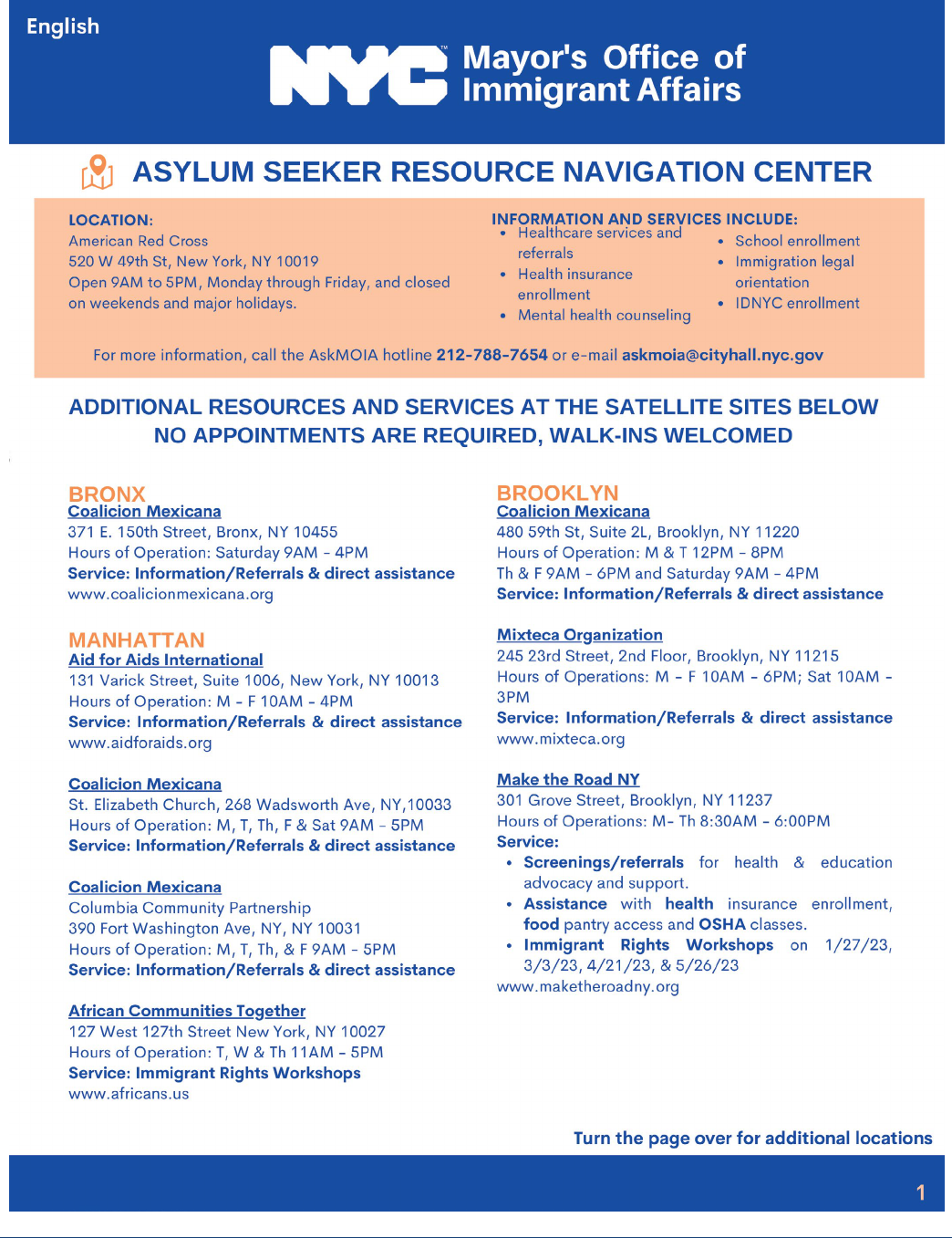
24 THE ROAD FORWARD
Appendix

25THE ROAD FORWARD
